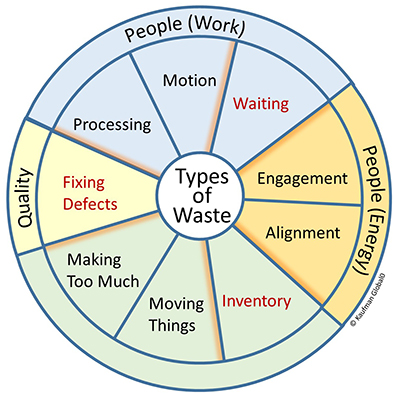Prioritize Manufacturing Fixes For Better Results
There are times when a manufacturing operation needs to get better (a lot better) — fast. This can be the result of many things. Often it’s in response to an external stimulus, such as competitive pressure, a quality “event,” or a troubled product launch. Sometimes it happens when customer demand increases without warning, where the “without warning” comes by way of truly new information and / or orders from the customer. Perhaps it’s because of a failure of internal sales and operations planning (S&OP) process — which happens more than anyone would like to admit. Or, it could simply be that the manufacturing operation has fallen into complacency and someone new comes in to disrupt the status quo. Whatever the reason, there are fundamental Lean manufacturing steps that should be taken to increase production. These types of changes are often inevitable and are often easier to achieve when thrust upon us.
Prioritize Improvement Activities by Aiming at Objectives

Lean Waste Wheel with People Energy Added and Top Priorities in Red
Lean manufacturing aims directly at factory throughput. A simple question to ask is: “How do we incrementally get more top quality product out the door with the same or fewer resources?” Taiichi Ohno’s waste wheel has a simple way of describing the things that get in the way of optimal throughput. The wheel describes seven classic wastes: Transportation, Inventory, Motion, Waiting, Over Production, Over Processing, and Defects. Within each one, there are many methods that can be applied for improving results. It only makes sense to give some priority to what to fix first.
The top three waste targets for improving manufacturing most quickly are: Waiting, Inventory and Defects. Everyplace IS different, but overall, these are the areas that get you furthest fastest. Most other forms of waste, and the methods to address them, fall in line under these.
Waiting Waste
Whether its machine capacity or human capital, there is no greater sin than waiting for product to move through the system. The question to ask is simple, “Why aren’t things moving?” The reasons are fairly standard: machines are down, there are missing people, parts and materials, etc. Many paths can be taken to fix these problems. It could be maintenance and machine downtime, or it could be organizational / skill versatility or shift-loading. Missing parts are often supply chain issues, such as forecasting and supplier management. In the end, the simplest question has many opportunities for discovery.
Inventory Waste
Inventory (e.g., raw, WIP, finished goods) is visible and extremely costly. It’s bad enough when you think about inventory in terms of the cash it represents. It’s even more frightening when you add the costs of moving it to the location where it sits, sorting it from time-to-time, and throwing it away when it becomes obsolete or a quality defect is detected. Only then do you begin to understand how despicable inventory really is. But that’s only part of the picture. There are other reasons why inventory is a logical first-strike target.
- Inventory not only disrupts throughput by physically getting in the way, but it also clouds throughput issues by masking problems. When inventory builds up, it disguises real issues that affect throughput and delivery. WIP covers up overall equipment effectiveness (OEE) and quality issues. Raw materials disguise supplier delivery and quality problems, and finished goods inventory mask gaps in on-time delivery.
- Inventory is the most visible attribute of a Lean versus a non-Lean operation. Not only does it show up throughout the operation, but it also shows up at headquarters where the people who measure results automatically assign dollars to inventory. A comprehensive reduction in inventory (i.e., an improvement in inventory turns) is a sign to the entire organization — from top-to-bottom — that something is improving. This is important to build enthusiasm for the dramatic changes taking place throughout the operation.
Defects Waste
Building bad product wastes time, energy and money because it’s already loaded with labor and material costs. On top of that, we add cost to detect, sort and fix defects. Quality is in the top three most important initial targets because it cannot suffer at the hands of the throughput objective. And, nothing will undermine an initiative to increase throughput faster than a quality problem delivered to the customer. In the automotive industry, recalls result in billions of dollars of lost value every year. In the Oil and Gas industry, a single quality problem leads to non-productive time (NPT) that can cost a million dollars per day. And, it’s not just the cost of fixing the problem that impacts businesses the most, it’s also the damage it causes to the supplier and customer relationship. The cost of the Macondo oil spill disaster (which was more a process quality issue than a material problem) is incalculable ― both in terms of tangible and intangible losses.
Everything Is Connected
Because the entire system is connected, addressing any one of these three wastes automatically impacts all the others described by Ohno. Ask good questions at the start and develop a plan of attack that always keeps your focus on the objective: “How do we incrementally get more top quality product out the door with the same or fewer resources?” Start with the few critical places where small improvements will have the greatest effect, and then develop an implementation plan that includes the broader organization in a holistic approach. When you’ve made it this far, you can then apply waste elimination tools, methods and techniques to your heart’s content.
To Learn more about Kaufman Global’s view on Lean manufacturing, download our White Paper: Implementing Lean Manufacturing: A Holistic Approach.






